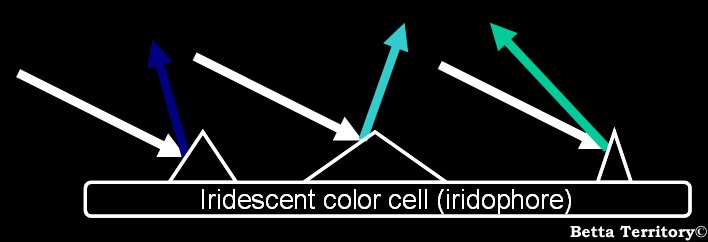With this post I would like to explain the concept of the iridescent structural colors a bit more. The iridescent colors are produced by light-reflective cells called iridophores. They produce iridescent colors by diffusion/scattering of light on colorless crystalline structures which are present on the surface of the cell (structural color). Something like this:
For more information about this please click here: Structural color.
In wild Betta splendens the normal turquoise/green iridescent color is limited to ray-like projections into the fins and several iridescent dots along the body. Selective breeding gave rise to a mutated iridescence gene (spread iridescence) which lead to an increase in density and distribution of the iridescent color covering the body and fins of the betta. Steel blue, Turquoise and Royal blue are known as the classical iridescent colors. Outcrossing Betta splendens to Betta imbellis introduced a 4th iridescent color: the yellow iridophore or better known as metallic. The metallic trait can influence many other color layers and so also the classical iridescent colors by changing the diffusion/scattering of the light (see picture above). This will influence what color we will see with our eyes.
For more information about this please click here:
– Genetics: Iridescent colors: Turquoise, Steel and Royal blue
– A “New” Iridophore Color.
– Inheritance of Metallic Trait.
– Naming the new metallic gene.
– Metallics and masks.
– Understanding metallic genetics.
As genes always come in pairs this means we can have either one copy of a gene (heterozygous) or two copies of a gene (homozygous), for more information about this click here: A closer look into the basics of genetics
When we now combine this information we can see this:
Non-metallic steel blue (blbl nmnm)
This is the classical steel blue type.
Heterozygous metallic steel blue (blbl +nm)
This is the classical steel blue type with one copy of the metallic gene added. The color is slightly different from normal steel blue as it is more shiny due to the metallic gene.
Homoygous metallic steel blue (blbl ++) or copper
This is the classical steel blue type with two copies of the metallic gene added. Now the color we see has changed to a copper phenotype.
Turquoise based colors:
Non-metallic turquoise (BlBl nmnm)
No picture available
Heterozygous metallic turquoise (BlBl +nm)
Homoygous metallic turquoise (BlBl ++)
Royal blue based colors:
Non-metallic royal blue (Blbl nmnm)
Heterozygous metallic royal blue (Blbl +nm)
Homoygous metallic royal blue (Blbl ++) or teal
Many greetings,
Joep
- Joep. “Understanding Iridescent Structure” www.Bettas4All, . Accessed – November 17 2013 <http://www.bettas4all.nl/viewtopic.php?f=27&t=7989&sid=50aeeeee8fe17c20e211a4b9508f80a0#.Uokr-PmX9yU>


.jpg)
.jpg)
.jpg)
.jpg)

.jpg)
.jpg)